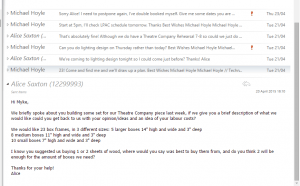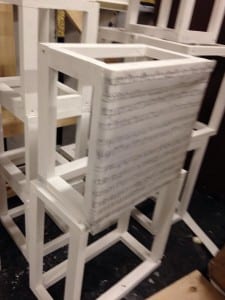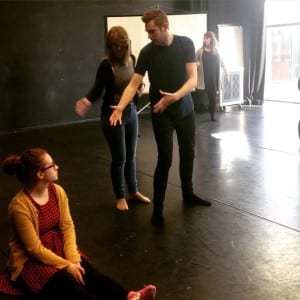Let’s do a warm up!
Warm up was a consistent part the rehearsals, every single rehearsal would start by warming up. All the work we were going to be doing was physical so to not warm up could end up hurting the cast. I would tailor the warm to fit the rehearsal, if we were going to be doing a lot of fast paced movement then we would do cardio, followed by stretches that we would be getting our hearts pumping and raising the heart rate to allow for the physical work to happen. We gradually build upon this by following it with star jumps and running then once fully warmed up we would then go onto stretched the now warm muscles. I fully believed that with consistent upkeep of the warm has led to the more flexibility in some of the cast members.
Managing The Space
As of January when our process began, I have been creating a company schedule. ‘A well organized rehearsal schedule is the key to dealing effectively with the stage management workload’ (Bond, 1991, 49) and allows both the creative and production sides of the company to remain on track. As of this week I have found the most effective way to create this schedule, is to dedicate 15minutes to the beginning of the rehearsal week to find out cast availability; although ideally the company would be free to partake in any rehearsals or meetings required of them, the circumstances in which we are creating this piece really hinders availability.
As seen by this schedule, we have been work-shopping for a few weeks now and more defined style and concept is beginning to emerge! Having discovered the illness Encephalitis, a form of the herpes simplex that transfers to the brain and causes severe memory loss, our piece has started to focus on the effects memory loss has upon relationships. In terms of production, some very distinctive ideas have surfaced. A couple of the company recently attended a show at Lincoln Drill Hall called Stateless (2014). The piece was inherently dance theatre, and thus the set had to be adaptable in order to allow the space the performers required – as, so far, our piece ia appearing very physical, this was an important idea for us to consider in these early stages. They used large, misshapen blocks that progressively came together to create one larger block. For myself and our company designer, this really inspired some concept ideas for set. In our most recent production meeting, we discussed having numerous blocks or boxes that come together to create an image. The boxes would incorporate photos, letters and objects that represented the memories of our characters. ‘The distinction between props and scenery gets muddy at times, and clear assignments should always be made’ (Campbell, 2004, 4), especially when all the aspects of your set can be handled and moved by the cast. In order to avoid this confusion, we have agreed that our designer will focus more-so on sourcing all props – ‘anything that is carried by the actor’ (Campbell, 2004, 4) – whilst I will begin to source the materials etc. for our set.
So far all of our technical ideas are quite sciencey in style, and I am extremely excited to see how this concept develops!
Works Cited
Bond, D. (1991) The Stage Management: A Gentle Art. New York: Routledge.
Cambell, D. (2004) Technical Theatre: For Nontechnical People. New York: Allworth Press
Joli Vyann. (2014) Stateless. [performance] Lincoln Drill Hall, 19th February 2015.
An Introduction to Set Design; Initial Ideas and Concepts
When first adopting the role of set designer, I was quite daunted by the lack of knowledge I had when it came to being in a production role and what I had to bring to the table in terms of props and set. To prepare for this role I attended regular Set Design masterclass ran by the Technical Designer for The Lincoln School of Fine and Performing Arts. This was extremely helpful as we covered topics such as different types of set, ground plans, director’s briefs and budgets. Being taught that as a set designer you have a responsibility for the stage to reflect the performance as best it can.
We worked on case studies and began to understand how a budget and the directors brief can either restrict ideas for shows or whether anything the imagination lets is possible, all depending on budget.
From these sessions I approached our director, Michael Woodhall and the rest of the design team to relay any ideas we had about the production side of our show. We came to the conclusion that because we were exploring an emotional and sensitive topic, memory loss and its effect on couples, relationships and their lives, it would be sensible and look atheistically pleasing to have the technical side, set and lights to reflect the science side of memory loss.
From the conception of our ideas to focus on memories I had a vision in my head of hanging objects, these could be personal objects or objects that would somehow become relevant in the show. However I was unsure of how this fit into keeping the technical side clinical. From research such as articles on memory loss and scientific viseos and descriptions on how the brain and memory works, the idea of storage came into mind, and then the idea of storage boxes and memory keep sake boxes. My head flooded with images of boxes littering the stage full of objects that have meanings and memory attached to them. To link it with the science of memory loss I drafted sketches of boxes littering the stage with ‘cables’ connecting them. The idea was that these boxes would represent the different compartments of the brain that store memory and the ‘cables’ would be the nerves or synapse s that connected each part. This idea stemmed from research on how the brain works, ranging from YouTube Videos to academic articles. Link below;
These snapshots below are the images that stuck with me when designing.
Pure Imagination
In the past week I’ve been doing a lot of research into memory loss and specific case studies. After our talks about people’s stories and what they have achieved, memory seems to have been something that has resonated with the company so we all decided to focus on memory and specifically memory loss. The first thing I did was to explore the science behind memory loss which has been incredibly fascinating. One case study I came across is of a patient famously known as ‘HM’. I found out the following:
“His global amnesia for new material was the result of the loss of both hippocampi, and meant that he could not learn new words, songs or faces after his surgery, forgot who he was talking to as soon as he turned away, didn’t know how old he was or if his parents were alive or dead, and never again clearly remembered an event, such as his birthday party, or who the current president of the United States was” (Ogden, 2012).
Another case study I found talked about which part of the brain were responsible for memory loss and about associations between different neurological conditions: “the hippocampus, which is responsible for forming new memories and for retaining old ones is vulnerable to a wide range of neurological conditions, including not only head injury, but also Alzheimer’s disease, encephalitis, epilepsy” (Rath, 2014).
This brought my attention to the disease encephalitis, it was the only one in the list that I hadn’t heard of before. Before now if anybody had asked me to name diseases associated with memory loss, encephalitis would not be an answer, however it seems to be an incredibly severe disease are there are many famous case studies of people suffering from it.
As well as doing lots of research we also took part in an imagination workshop led by Michael W. this week. The point of the workshop was to come up with a nonsense story as a whole group (it was a very emotional tale of a poor pig who had bad breath and had no friends, but ended up with a wolf best friend). We then split off into two groups and developed it into performance. I worked in a group with Alice D., Naomi, and Rachel. What we created was very different to the other group although we both used a physical style. Another issue this exercise flagged up was that although we both had the same source material, the stories were represented slightly differently. This showed us that we need to be very careful if we are going to use case studies that we don’t change facts or misrepresent anybody.

Works Cited
Rath, A. (2014) From One Man’s Damaged Brain, A Treasure Trove Of Research On Memory. [online] Available from: http://www.npr.org/2014/12/28/373657735/from-one-damaged-brain-a-treasure-trove-of-data-on-memory [Accessed March 1 2015].
Ogden, J. (2012) HM, the Man with No Memory. [online] Available from: https://www.psychologytoday.com/blog/trouble-in-mind/201201/hm-the-man-no-memory [Accessed March 1 2015].
Workshops: Making time to play and use our imaginations!
This past week, I have been leading some creative workshops to get ideas flowing and to get the company comfortable working as an ensemble. Some of the workshops have been focused on the stories we hold as a group. As we are interested in interviewing the public and visualising personal stories, specifically related to memories and regrets, I felt that it was important for us share our own stories first. This would then make it easier to know how sensitive we need to be when dealing with external material.
One exercise I gave our actors was to write a letter they would like to send to someone but for some reason, they can’t. They then paired up and picked one of the letters at random and each pair physicalised the narrative of the letter. I asked the performers to think about the emotion behind the letter; apart from that, I had no direct instructions for them as I felt I needed to give the performers opportunities to have a creative input, ‘by setting tasks you allow your performers to offer much creative input into the devising of choreography without burdening them with the responsibility of creating the whole show.’ (Graham, 2014, p. 15) I then merged some of the sequences together and played around with music which resulted in a short physical piece which myself and Rachel, our choreographer, can carry on developing further.
(Katherine Copley, 2015)
The Frantic Assembly book of devising theatre has been a key tool which has inspired a couple of my workshops. At the beginning of their devising process, Frantic usually divert from the topic of their piece as they feel it can restrain the imaginations of the performers. This is something I wanted to implicate into some of our workshops, a good example of this is when I asked our designers to gather some props together; the performers all chose a prop at random and were asked to create a short improvised piece where they were to use these particular props but not for their original purpose. This exercise has been essential for the development of our show as I am particularly interested in using objects and props to aid us in our storytelling. Additionally, the exercise has allowed the performers to spend time being playful and expanding their imaginations which I feel is essential at the beginning of a devising process as ‘it’s when you’re most playful that you create the best work.’ (Mcdonnell, 2015)
All of the material from the workshops has been recorded on film and has begun to inspire me with more creative ideas resulting in a stronger framework. I cannot wait to see the piece develop further over the next few weeks!
Works Cited
Graham, S. and Hoggett, S. (2014) The Frantic Assembly book of devising theatre. Second edition. Oxon: Routledge.
Mcdonnell, J. (2015) Career advice from The Paper Birds Theatre Company. [interview] Interviewed by Michael Woodhall, 12 February.




